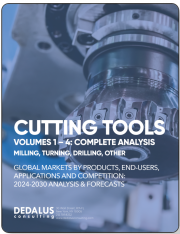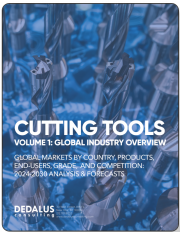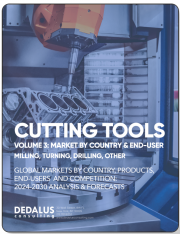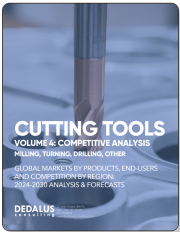
|
시장보고서
상품코드
1856743
톱 및 절단 공구 시장 : 최종 용도 산업별, 공구 유형별, 동력원별, 조작 모드별, 절단 재료별, 블레이드 유형별, 판매 채널별 - 세계 예측(2025-2032년)Sawing & Cutting Tools Market by End Use Industry, Tool Type, Power Source, Operation Mode, Cutting Material, Blade Type, Sales Channel - Global Forecast 2025-2032 |
||||||
톱·절단 공구 시장은 2032년까지 CAGR 8.63%로 45억 3,000만 달러로 성장할 것으로 예측됩니다.
| 주요 시장 통계 | |
|---|---|
| 기준연도 2024 | 23억 3,000만 달러 |
| 추정연도 2025 | 25억 4,000만 달러 |
| 예측연도 2032 | 45억 3,000만 달러 |
| CAGR(%) | 8.63% |
톱 및 절삭 공구 수요를 형성하는 재료의 혁신, 채널의 변화, 경쟁의 급박함을 이해하기 위한 이해관계자를 위한 전략적 프레임 워크
톱 및 절삭 공구 부문은 재료 과학 혁신, 산업 자동화 및 공급망 우선 순위의 변화의 교차점에 위치하여 제조업체와 최종사용자가 용도 전반에 걸쳐 정밀 절삭에 접근하는 방식을 형성하고 있습니다. 최근 수년간 칼날의 야금학 및 기계 제어 시스템의 기술 발전으로 기대되는 성능이 재정의되고, 항공우주, 자동차, 의료 분야의 고객 요구가 진화하면서 더 높은 공차 및 처리량에 대한 수요가 증가하고 있습니다. 따라서 기업은 경쟁력을 유지하기 위해 내구성이 뛰어난 소모품에 대한 투자와 더 스마트한 전동 공구 및 자동화된 절삭 셀에 대한 설비 투자의 균형을 유지해야 합니다.
동시에, 조달 모델의 변화와 온라인 판매 채널의 확산으로 인해 전통적 공급업체와의 관계가 변화하고 공구 제조업체와 유통 업체는 마진 구조와 서비스 내용에 대한 재평가를 요구하고 있습니다. 이러한 역동적인 환경은 이해관계자들에게 제품 수준의 혁신뿐만 아니라 절삭 재료 구성 및 블레이드 접합 기술의 인접 동향에 대한 모니터링도 요구하고 있습니다. 시장 진출기업은 타겟팅된 연구개발, 전략적 파트너십, 선택적 채널 최적화를 통해 시장 충격에 대한 내성을 강화하고 고성장 부문에서 점유율을 확보할 수 있는 체제를 갖출 수 있습니다.
미래를 내다볼 때, 가장 성공적인 기업은 엔지니어링, 공급망, 상업적 인텔리전스를 결합하여 기능 간 인사이트를 통합하고, 제품 포트폴리오를 새로운 최종 사용처의 요구사항에 맞게 조정할 것으로 보입니다. 이를 통해 산업계와 전문가 사용자 그룹 모두에서 점진적인 효율성 향상을 지속가능한 경쟁 우위로 전환할 수 있습니다.
재료 과학의 혁신, 디지털화, 공급망 강인성이 어떻게 융합되어 톱과 절삭 공구의 경쟁 모델을 재정의하고 있는가?
톱 및 절삭 공구의 환경은 경쟁의 경계와 가치 제안을 재정의하는 여러 가지 변혁적 변화로 인해 재편되고 있습니다. 초경합금, 바이메탈 구조, 다이아몬드 본딩 등 칼날 소재의 발전으로 절삭 수명과 정밀도가 향상되어 이전에는 비용적으로 어려웠던 복합재료와 경화합금의 새로운 용도가 가능해졌습니다. 이와 함께 전동화 추세와 무선 공구 아키텍처의 부상으로 이동성과 현장 생산성이 향상되고, 통합 전자제어 및 센서 지원 시스템을 통해 예지보전 및 공정 최적화 기능이 도입되었습니다.
또한 공급망 탄력성이 전략적 과제로 떠오르면서 제조업체들은 조달처 다변화, 지역 생산에 대한 투자, 재고 전략 재구축, 관세 노출 및 물류 불안정성 완화를 위해 노력하고 있습니다. 디지털 커머스 플랫폼도 성숙해지면서 제조업체는 중소기업에 직접 접근하여 제품 개발 및 애프터서비스에 도움이 되는 데이터를 얻을 수 있게 되었습니다. 마지막으로 사용 후 제품 폐기 및 금형 제조의 체적 에너지와 같은 규제와 지속가능성에 대한 고려는 기업이 순환 경제 원칙을 채택하고 안목 있는 구매자에게 수명주기 성능을 알릴 수 있도록 유도하고 있습니다.
이러한 변화는 고립된 것이 아니라 서로 영향을 미치고받으며 제품 성능, 서비스성, 공급의 신뢰성이 똑같이 중요한 새로운 비즈니스 모델을 만들어내고 있습니다. 기업이 성공하기 위해서는 R&D, 디지털화, 공급망 재설계에 걸친 체계적인 투자를 통해 이러한 파괴적인 힘을 차별화와 장기적인 성장의 기회로 전환해야 합니다.
2025년까지 미국의 관세 정책이 절삭공구 조달 발자국, 조달 전략, 산업 구조조정 역학을 어떻게 변화시켰는지에 대한 평가
2025년까지 시행되는 미국의 관세 조치의 누적된 영향은 목재 및 절삭 공구 생태계 전반에 걸쳐 공급망, 조달 결정 및 비용 구조에 심각한 압력을 가하고 있습니다. 관세 조치는 특정 수입 블레이드, 톱 조립, 보조 부품의 상륙 비용을 인상하여 OEM, 유통 업체, 최종사용자의 일련의 반응을 일으켰습니다. 가격 경쟁력을 유지하기 위해 원가 상승을 흡수하는 방식으로 대응한 업체도 있고, 관세의 영향을 피하기 위해 벤더와의 계약을 재구성하고 고부가가치 생산 활동을 국내 또는 인근 시설로 전환한 업체도 있습니다.
그 결과, 조달 전략의 동향은 정부 기관 및 중요 인프라 고객과의 계약 자격을 유지하기 위해 인증된 현지 조달 비율에 중점을 두면서 이중 소싱과 장기 공급업체 계약으로 기울어지고 있습니다. 또한 수입에 의존하는 소규모 기업은 가격 조정과 안정적인 공급을 확보하기 어렵기 때문에 이윤이 적은 특정 분야에서는 통합이 가속화되었습니다. 산업 구매자에게는 관세 중심의 비용 환경은 총 소유 비용 분석의 가치를 높이고 단가 상승을 상쇄하기 위해 공구의 내구성, 정비 간격 및 교체 주기를 면밀히 조사하도록 유도했습니다.
또한 규제 준수와 관세 분류의 복잡성으로 인해 기업은 관세 엔지니어링, 관세 분류 검토, 자유무역협정 활용 등 관세 절감 전략을 최적화하기 위해 무역 및 관세 전문 지식에 투자해야 하는 상황이 발생했습니다. 이러한 대응이 관세의 영향을 배제하는 것은 아니지만, 많은 기업이 혼란에 대처하고 비즈니스 연속성을 유지하는 데 도움이 되고 있으며, 궁극적으로 조달 발자국을 재구성하고 온쇼어링 및 현지화된 공급망으로의 추세를 가속화하고 있습니다.
업종, 공구 아키텍처, 파워 시스템, 블레이드 화학, 진화하는 채널 전략에서 차별화된 수요 동인을 파악할 수 있는 심층적인 세분화 인사이트를 제공
부문 수준 분석은 최종 용도, 툴 아키텍처, 채널 선호도에 따른 차별화된 역학을 밝혀내고, 이를 통해 경쟁 포지셔닝과 혁신의 우선순위를 결정합니다. 항공우주, 자동차, 건설, 에너지/전력, 제조, 의료/헬스케어 등 최종 사용 산업별로는 각 분야마다 미묘하게 다른 수요 촉진요인이 존재하며, 각 분야는 미세가공, 절삭 속도, 오염 제어 등 각기 다른 성능 속성을 우선시하고 있습니다. 제품 유형별로 보면 제품수명주기과 A/S는 띠톱, 원형톱, 손톱, 퍼즐톱, 왕복톱, 테이블톱에 따라 자본집약도와 교체주기가 크게 다릅니다.
목차
제1장 서문
제2장 조사 방법
제3장 개요
제4장 시장 개요
제5장 시장 인사이트
제6장 미국 관세의 누적 영향 2025
제7장 AI의 누적 영향 2025
제8장 톱·절단 공구 시장 : 최종 용도 산업별
- 항공우주
- 자동차
- 건설
- 에너지 & 전력
- 제조업
- 의료·헬스케어
제9장 톱·절단 공구 시장 : 공구 유형별
- 밴드 소
- 원형톱
- 핸드 소
- Jigsaw
- 왕복 톱
- 테이블 소
제10장 톱·절단 공구 시장 : 전원별
- 전기식
- 코드식
- 무선
- 유압
- 수동
- 공기압
제11장 톱·절단 공구 시장 : 동작 모드별
- 핸드헬드
- 고정형
제12장 톱·절단 공구 시장 : 절단 재료별
- 복합재료
- 금속
- 플라스틱
- 목재
제13장 톱·절단 공구 시장 : 블레이드 유형별
- 바이메탈
- 초경 팁
- 다이아몬드
- 전기 도금
- 수지 접착
- 고속도강
제14장 톱·절단 공구 시장 : 판매 채널별
- 직접 판매
- 판매업체
- 온라인 소매
- 제조업체 웹사이트
- 마켓플레이스
- 전문점
제15장 톱·절단 공구 시장 : 지역별
- 아메리카
- 북미
- 라틴아메리카
- 유럽, 중동 및 아프리카
- 유럽
- 중동
- 아프리카
- 아시아태평양
제16장 톱·절단 공구 시장 : 그룹별
- ASEAN
- GCC
- EU
- BRICS
- G7
- NATO
제17장 톱·절단 공구 시장 : 국가별
- 미국
- 캐나다
- 멕시코
- 브라질
- 영국
- 독일
- 프랑스
- 러시아
- 이탈리아
- 스페인
- 중국
- 인도
- 일본
- 호주
- 한국
제18장 경쟁 구도
- 시장 점유율 분석, 2024
- FPNV 포지셔닝 매트릭스, 2024
- 경쟁사 분석
- Robert Bosch GmbH
- Stanley Black & Decker, Inc.
- Makita Corporation
- Hilti AG
- Metabo GmbH
- TTS Tooltechnic Systems GmbH
- Sandvik AB
- Kennametal Inc.
- Sumitomo Electric Industries, Ltd.
- Mitsubishi Materials Corporation
The Sawing & Cutting Tools Market is projected to grow by USD 4.53 billion at a CAGR of 8.63% by 2032.
| KEY MARKET STATISTICS | |
|---|---|
| Base Year [2024] | USD 2.33 billion |
| Estimated Year [2025] | USD 2.54 billion |
| Forecast Year [2032] | USD 4.53 billion |
| CAGR (%) | 8.63% |
A strategic framing for stakeholders to understand material innovations, channel shifts, and competitive imperatives shaping sawing and cutting tool demand
The sawing and cutting tools sector sits at the intersection of material science innovation, industrial automation, and shifting supply chain priorities, shaping how manufacturers and end users approach precision cutting across applications. In recent years, technological advances in blade metallurgy and machine control systems have redefined performance expectations, while evolving customer needs in aerospace, automotive and medical sectors have driven demand for higher tolerance and throughput. As a result, companies must balance investments in durable consumables with capital expenditures on smarter power tools and automated cutting cells to remain competitive.
Concurrently, changing procurement models and the proliferation of online sales channels have altered traditional vendor relationships, prompting toolmakers and distributors to re-evaluate margin structures and service offerings. This dynamic environment compels stakeholders to monitor not only product-level innovations but also adjacent trends in cutting material composition and blade bonding technologies. Through a combination of targeted R&D, strategic partnerships and selective channel optimization, industry participants can strengthen resilience against market shocks and position themselves to capture share in high-growth segments.
Looking ahead, the most successful organizations will integrate cross-functional insights-combining engineering, supply chain and commercial intelligence-to align product portfolios with emergent end-use requirements. By doing so, they can convert incremental efficiency gains into sustainable competitive advantage across both industrial and professional user groups.
How material science breakthroughs, digitalization, and supply chain resilience are converging to redefine competitive models in sawing and cutting tools
The landscape for sawing and cutting tools has been reshaped by multiple transformative shifts that are redefining competitive boundaries and value propositions. Advances in blade materials such as carbide, bi-metal constructions and diamond bonding have increased cut life and precision, enabling new applications in composites and hardened alloys that were previously cost-prohibitive. In parallel, electrification trends and the rise of cordless tool architectures have elevated mobility and on-site productivity, while integrated electronic controls and sensor-enabled systems have introduced predictive maintenance and process optimization capabilities.
Moreover, supply chain resilience has climbed the strategic agenda, prompting manufacturers to diversify sourcing, invest in regional manufacture and reconfigure inventory strategies to mitigate tariff exposure and logistics volatility. Digital commerce platforms have also matured, allowing manufacturers to reach small and medium enterprises directly and capture data that informs product development and after-sales services. Finally, regulatory and sustainability considerations, including end-of-life disposal and embodied energy in tooling production, are encouraging firms to adopt circular economy principles and to communicate lifecycle performance to discerning buyers.
Collectively, these shifts are not isolated; they interact to create new business models in which product performance, serviceability and supply reliability are equally critical. To succeed, firms must orchestrate investments across R&D, digital enablement and supply chain redesign, turning these disruptive forces into opportunities for differentiation and long-term growth.
Assessment of how U.S. tariff policy through 2025 has altered sourcing footprints, procurement strategy, and industry consolidation dynamics in cutting tools
The cumulative impact of United States tariff measures implemented through 2025 has exerted material pressure on supply chains, sourcing decisions and cost structures across the sawing and cutting tools ecosystem. Tariff actions have increased landed costs for certain imported blades, saw assemblies and ancillary components, triggering a sequence of reactions from OEMs, distributors and end users. Some manufacturers responded by absorbing incremental costs to preserve price competitiveness, while others restructured vendor agreements and shifted higher-value production activities to domestic or nearshore facilities to avoid tariff exposure.
Consequently, procurement strategies have trended toward dual-sourcing and longer-term supplier contracts, with an emphasis on certified local content to maintain contract eligibility with government and critical infrastructure customers. In addition, certain segments with thin margins experienced accelerated consolidation as smaller import-dependent players found it difficult to adjust pricing or secure reliable supply. For industrial buyers, the tariff-driven cost environment reinforced the value of total cost-of-ownership analysis, prompting increased scrutiny of tool durability, maintenance intervals and replacement cycles to offset unit-price increases.
Furthermore, regulatory compliance and customs classification complexity pushed firms to invest in trade and tariff expertise to optimize duty mitigation strategies, such as tariff engineering, tariff classification reviews, and utilization of free trade agreements where applicable. While these responses do not eliminate the impact of tariffs, they have helped many organizations manage disruption and preserve operational continuity, ultimately reshaping sourcing footprints and accelerating trends toward onshoring and localized supply networks.
Deep segmentation insights that reveal differentiated demand drivers across industries, tool architectures, power systems, blade chemistries, and evolving channel strategies
Segment-level analysis reveals differentiated dynamics driven by end-use, tool architecture and channel preferences, which together shape competitive positioning and innovation priorities. Based on End Use Industry, the market experiences nuanced demand drivers across Aerospace, Automotive, Construction, Energy & Power, Manufacturing, and Medical & Healthcare, with each sector prioritizing different performance attributes such as microfinish, cut speed or contamination control. Based on Tool Type, product lifecycles and aftermarket services vary between Bandsaw, Circular Saw, Hand Saw, Jigsaw, Reciprocating Saw, and Table Saw, where capital intensity and replacement cycles diverge significantly.
Based on Power Source, adoption curves differ between Electric, Hydraulic, Manual, and Pneumatic offerings, with Electric solutions-further separated into Corded and Cordless-gaining ground due to advances in battery efficiency and motor control. Based on Operation Mode, distinctions between Handheld and Stationary applications influence ergonomics, safety requirements and integration into automated workflows. Based on Cutting Material, tools and blade chemistry are optimized for Composite, Metal, Plastic, and Wood substrates, which alters consumable design and inventory strategies.
Based on Blade Type, the choice among Bi-Metal, Carbide Tipped, Diamond, and High-Speed Steel blades-where Diamond is further studied across Electroplated and Resin Bonded variants-dictates pricing, lifecycle economics and downstream machining quality. Finally, based on Sales Channel, distribution efficiency and customer experience vary across Direct Sales, Distributor, Online Retail, and Specialty Store channels, with Online Retail further subdivided into Manufacturer Website and Marketplaces, influencing how brands manage direct engagement and after-sales service. These segmentation lenses collectively inform product roadmap decisions, channel investments and service models that companies should prioritize to capture differentiated value in target niches.
Regional market dynamics that dictate production siting, service ecosystems, and go-to-market differentiation across the Americas, EMEA, and Asia-Pacific
Regional dynamics materially influence competitive advantage, investment focus and go-to-market strategies for manufacturers and distributors. In the Americas, demand is driven by infrastructure upgrades, automotive production clusters and a preference for locally supported after-sales service, which elevates the importance of regional inventory and field service networks. Conversely, Europe, Middle East & Africa presents a blend of advanced manufacturing pockets and resource-driven markets where regulatory rigor, sustainability expectations and standards compliance shape product specifications and procurement policies.
In Asia-Pacific, broad-based industrialization and a large manufacturing base have supported high volumes and intense competition, while domestic innovation hubs are advancing metallurgy and automation integration. Moreover, regional tariff regimes, trade agreements and logistics infrastructure contribute to strategic decisions about where to site production and distribution facilities. These geographic variances also affect talent availability for precision fabrication, R&D intensity and the maturity of digital sales channels.
Taken together, regional realities influence not only sales and marketing priorities but also decisions about product customization, certification, and partner ecosystems. Firms that align regional go-to-market tactics with local technical requirements and service expectations will capture a sustainable edge in capture-and-retention of both industrial and professional customers.
How technology investments, strategic partnerships, and service innovation are reshaping competitive positioning among blade specialists, OEMs, and digital distributors
Competitive intensity in the sawing and cutting tools space is shaped by a mix of legacy manufacturers, specialized blade technologists, and digitally native distributors that emphasize customer experience and data-driven service. Leading firms differentiate by investing in metallurgical R&D, process automation and predictive service offerings that extend consumable life and reduce downtime. Others focus on channel optimization, building direct-to-customer digital propositions that complement traditional distributor networks and provide access to usage data for product refinement.
Mergers, strategic partnerships and targeted acquisitions have been used to acquire niche capabilities such as diamond bonding processes, advanced coatings or automation integration expertise. Companies that concentrate on modular product architectures and standardized interfaces can accelerate OEM integration and expand into adjacent markets, while those that emphasize manufacturing excellence and quality certifications maintain strong traction in regulated sectors like aerospace and medical.
Additionally, aftermarket support and training services represent significant differentiators; organizations that deliver field training, tool lifecycle management and consumable subscription models create higher switching costs and deeper customer relationships. To maintain momentum, companies should balance investments in core manufacturing competencies with digital enablement and service innovation, ensuring they can respond rapidly to customer-driven technical requirements and evolving procurement behaviors.
Practical strategic moves for manufacturers and distributors to align innovation, sourcing resilience, and digital service models for durable competitive advantage
Industry leaders should focus on pragmatic, high-impact actions that align product innovation with resilient supply chains and customer-centric channels. First, prioritize investment in blade and tool technologies that demonstrably extend life and lower total cost of ownership, pairing material science advances with rigorous field testing so that performance claims translate into verified outcomes. Second, diversify sourcing and establish qualified supplier tiers, incorporating nearshoring or regional manufacturing where it materially reduces exposure to trade measures and logistics complexity.
Third, accelerate the digitization of aftermarket services to capture usage data and to deploy predictive maintenance offerings that strengthen customer retention and create recurring revenue streams. Fourth, refine channel strategy by balancing direct digital engagement with distributor partnerships, ensuring consistent brand experience while leveraging distributor reach in specialized segments. Fifth, build robust capability in regulatory and trade compliance to optimize duty mitigation and classification, which will preserve margin and reduce transactional friction.
Finally, align organizational incentives to support cross-functional collaboration between R&D, operations, and commercial teams so that innovations are manufacturable and sellable at scale. By executing these interlocking recommendations, companies can convert current market turbulence into durable operational advantages and sustained commercial growth.
A mixed-methods approach combining primary stakeholder engagement, technical validation, and trade analysis to produce actionable and verifiable industry insights
The research methodology underpinning these insights combined structured primary engagement with rigorous secondary validation to ensure analytical accuracy and relevance. Primary inputs included in-depth interviews with engineering leaders, procurement executives, and senior product managers across tool manufacturers, blade suppliers and end-use companies, providing firsthand perspectives on performance priorities and procurement trade-offs. These qualitative conversations were complemented by site visits and technical briefings to observe production practices, testing protocols and end-user application scenarios.
Secondary validation encompassed review of patent filings, industry standards, trade classifications, and public regulatory documentation to corroborate technology trends and compliance drivers. In addition, analysis of trade flows and customs schedules informed assessments of tariff impact and supply chain reconfiguration without relying on proprietary forecasting models. Cross-checks with supplier catalogs, white papers, and independent technical evaluations ensured that material and blade performance claims were grounded in demonstrable testing and engineering principles.
Throughout the process, triangulation was applied to reconcile differing viewpoints, and findings were iteratively refined through stakeholder feedback loops to improve clarity and actionability. This mixed-method approach produced a robust evidence base that supports the strategic conclusions and recommendations presented in this document.
Synthesis of market forces showing how aligned innovation, supply chain resilience, and digital service models will determine long-term leadership in cutting tools
In conclusion, the sawing and cutting tools sector stands at an inflection point where material innovation, supply chain strategy and digital service models jointly determine competitive success. Advances in blade chemistry and bonding techniques are enabling new applications and extending consumable life, while electrification and embedded electronics are enhancing tool utility and predictive maintenance capabilities. At the same time, tariff dynamics and regional disparities have accelerated supply chain reconfiguration and prompted closer attention to local manufacturing, dual sourcing and inventory resiliency.
Companies that successfully translate these dynamics into advantage will combine deep technical expertise with agile commercial models and robust compliance capabilities. They will prioritize investments that lower customer total cost of ownership, deepen after-sales relationships, and enable rapid response to regulatory and market changes. By integrating R&D, operations and commercial teams around clear customer outcomes, organizations can navigate current uncertainty and create a platform for sustainable growth.
Moving forward, decision-makers should view innovation, supply chain resilience and digital engagement not as separate imperatives but as interdependent levers that, when aligned, produce outsized business results. This holistic approach will be essential for capturing opportunity in complex end-use markets and for maintaining relevance in an increasingly competitive global landscape.
Table of Contents
1. Preface
- 1.1. Objectives of the Study
- 1.2. Market Segmentation & Coverage
- 1.3. Years Considered for the Study
- 1.4. Currency & Pricing
- 1.5. Language
- 1.6. Stakeholders
2. Research Methodology
3. Executive Summary
4. Market Overview
5. Market Insights
- 5.1. Increased demand for carbide-tipped circular saw blades in precision metal cutting applications due to durability and cost efficiency
- 5.2. Integration of IoT-enabled monitoring systems in industrial band saws for predictive maintenance and reduced downtime
- 5.3. Growth in laser cutting tool adoption for complex composite materials in aerospace manufacturing
- 5.4. Development of eco-friendly biodegradable diamond-coated cutting discs to meet sustainability regulations
- 5.5. Rising implementation of robotic sawing cells with advanced vision systems for automated wood processing lines
- 5.6. Expansion of online direct-to-end-user sales channels for specialized cutting tools with digital customization features
6. Cumulative Impact of United States Tariffs 2025
7. Cumulative Impact of Artificial Intelligence 2025
8. Sawing & Cutting Tools Market, by End Use Industry
- 8.1. Aerospace
- 8.2. Automotive
- 8.3. Construction
- 8.4. Energy & Power
- 8.5. Manufacturing
- 8.6. Medical & Healthcare
9. Sawing & Cutting Tools Market, by Tool Type
- 9.1. Bandsaw
- 9.2. Circular Saw
- 9.3. Hand Saw
- 9.4. Jigsaw
- 9.5. Reciprocating Saw
- 9.6. Table Saw
10. Sawing & Cutting Tools Market, by Power Source
- 10.1. Electric
- 10.1.1. Corded
- 10.1.2. Cordless
- 10.2. Hydraulic
- 10.3. Manual
- 10.4. Pneumatic
11. Sawing & Cutting Tools Market, by Operation Mode
- 11.1. Handheld
- 11.2. Stationary
12. Sawing & Cutting Tools Market, by Cutting Material
- 12.1. Composite
- 12.2. Metal
- 12.3. Plastic
- 12.4. Wood
13. Sawing & Cutting Tools Market, by Blade Type
- 13.1. Bi-Metal
- 13.2. Carbide Tipped
- 13.3. Diamond
- 13.3.1. Electroplated
- 13.3.2. Resin Bonded
- 13.4. High-Speed Steel
14. Sawing & Cutting Tools Market, by Sales Channel
- 14.1. Direct Sales
- 14.2. Distributor
- 14.3. Online Retail
- 14.3.1. Manufacturer Website
- 14.3.2. Marketplaces
- 14.4. Specialty Store
15. Sawing & Cutting Tools Market, by Region
- 15.1. Americas
- 15.1.1. North America
- 15.1.2. Latin America
- 15.2. Europe, Middle East & Africa
- 15.2.1. Europe
- 15.2.2. Middle East
- 15.2.3. Africa
- 15.3. Asia-Pacific
16. Sawing & Cutting Tools Market, by Group
- 16.1. ASEAN
- 16.2. GCC
- 16.3. European Union
- 16.4. BRICS
- 16.5. G7
- 16.6. NATO
17. Sawing & Cutting Tools Market, by Country
- 17.1. United States
- 17.2. Canada
- 17.3. Mexico
- 17.4. Brazil
- 17.5. United Kingdom
- 17.6. Germany
- 17.7. France
- 17.8. Russia
- 17.9. Italy
- 17.10. Spain
- 17.11. China
- 17.12. India
- 17.13. Japan
- 17.14. Australia
- 17.15. South Korea
18. Competitive Landscape
- 18.1. Market Share Analysis, 2024
- 18.2. FPNV Positioning Matrix, 2024
- 18.3. Competitive Analysis
- 18.3.1. Robert Bosch GmbH
- 18.3.2. Stanley Black & Decker, Inc.
- 18.3.3. Makita Corporation
- 18.3.4. Hilti AG
- 18.3.5. Metabo GmbH
- 18.3.6. TTS Tooltechnic Systems GmbH
- 18.3.7. Sandvik AB
- 18.3.8. Kennametal Inc.
- 18.3.9. Sumitomo Electric Industries, Ltd.
- 18.3.10. Mitsubishi Materials Corporation



















